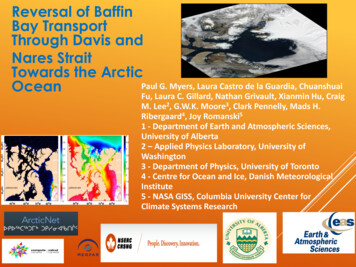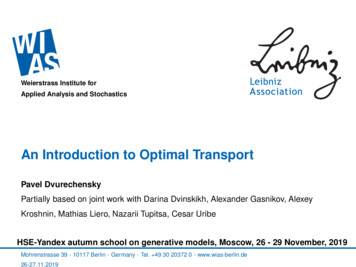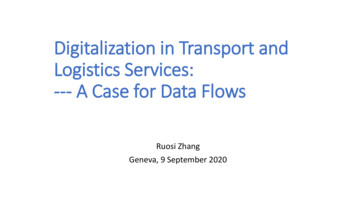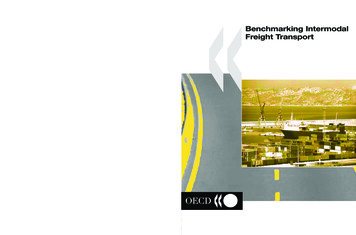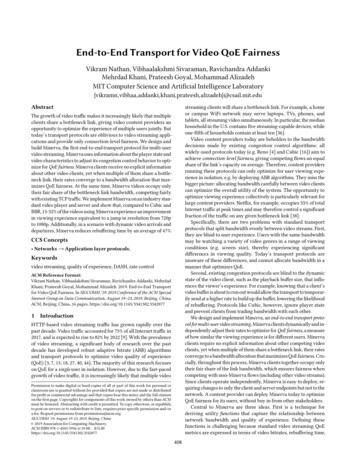
Transcription
End-to-End Transport for Video QoE FairnessVikram Nathan, Vibhaalakshmi Sivaraman, Ravichandra AddankiMehrdad Khani, Prateesh Goyal, Mohammad AlizadehMIT Computer Science and Artificial Intelligence lizadeh}@csail.mit.eduAbstractstreaming clients will share a bottleneck link. For example, a homeor campus WiFi network may serve laptops, TVs, phones, andtablets, all streaming video simultaneously. In particular, the medianhousehold in the U.S. contains five streaming-capable devices, whileone-fifth of households contain at least ten [36].Video content providers today are beholden to the bandwidthdecisions made by existing congestion control algorithms: allwidely-used protocols today (e.g. Reno [4] and Cubic [16]) aim toachieve connection-level fairness, giving competing flows an equalshare of the link’s capacity on average. Therefore, content providersrunning these protocols can only optimize for user viewing experience in isolation, e.g. by deploying ABR algorithms. They miss thebigger picture: allocating bandwidth carefully between video clientscan optimize the overall utility of the system. The opportunity tooptimize viewing experience collectively is particularly relevant forlarge content providers. Netflix, for example, occupies 35% of totalInternet traffic at peak times and may therefore control a significantfraction of the traffic on any given bottleneck link [38].Specifically, there are two problems with standard transportprotocols that split bandwidth evenly between video streams. First,they are blind to user experience. Users with the same bandwidthmay be watching a variety of video genres in a range of viewingconditions (e.g. screen size), thereby experiencing significantdifferences in viewing quality. Today’s transport protocols areunaware of these differences, and cannot allocate bandwidth in amanner that optimizes QoE.Second, existing congestion protocols are blind to the dynamicstate of the video client, such as the playback buffer size, that influences the viewer’s experience. For example, knowing that a client’svideo buffer is about to run out would allow the transport to temporarily send at a higher rate to build up the buffer, lowering the likelihoodof rebuffering. Protocols like Cubic, however, ignore player stateand prevent clients from trading bandwidth with each other.We design and implement Minerva, an end-to-end transport protocol for multi-user video streaming. Minerva clients dynamically and independently adjust their rates to optimize for QoE fairness, a measureof how similar the viewing experience is for different users. Minervaclients require no explicit information about other competing videoclients, yet when multiple of them share a bottleneck link, their ratesconverge to a bandwidth allocation that maximizes QoE fairness. Crucially, throughout this process, Minerva clients together occupy onlytheir fair share of the link bandwidth, which ensures fairness whencompeting with non-Minerva flows (including other video streams).Since clients operate independently, Minerva is easy to deploy, requiring changes to only the client and server endpoints but not to thenetwork. A content provider can deploy Minerva today to optimizeQoE fairness for its users, without buy in from other stakeholders.Central to Minerva are three ideas. First is a technique forderiving utility functions that capture the relationship betweennetwork bandwidth and quality of experience. Defining thesefunctions is challenging because standard video streaming QoEmetrics are expressed in terms of video bitrates, rebuffering time,The growth of video traffic makes it increasingly likely that multipleclients share a bottleneck link, giving video content providers anopportunity to optimize the experience of multiple users jointly. Buttoday’s transport protocols are oblivious to video streaming applications and provide only connection-level fairness. We design andbuild Minerva, the first end-to-end transport protocol for multi-uservideo streaming. Minerva uses information about the player state andvideo characteristics to adjust its congestion control behavior to optimize for QoE fairness. Minerva clients receive no explicit informationabout other video clients, yet when multiple of them share a bottleneck link, their rates converge to a bandwidth allocation that maximizes QoE fairness. At the same time, Minerva videos occupy onlytheir fair share of the bottleneck link bandwidth, competing fairlywith existing TCP traffic. We implement Minerva on an industry standard video player and server and show that, compared to Cubic andBBR, 15-32% of the videos using Minerva experience an improvementin viewing experience equivalent to a jump in resolution from 720pto 1080p. Additionally, in a scenario with dynamic video arrivals anddepartures, Minerva reduces rebuffering time by an average of 47%.CCS Concepts Networks Application layer protocols;Keywordsvideo streaming, quality of experience, DASH, rate controlACM Reference Format:Vikram Nathan, Vibhaalakshmi Sivaraman, Ravichandra Addanki, MehrdadKhani, Prateesh Goyal, Mohammad Alizadeh. 2019. End-to-End Transportfor Video QoE Fairness. In SIGCOMM ’19: 2019 Conference of the ACM SpecialInterest Group on Data Communication, August 19–23, 2019, Beijing, China.ACM, Beijing, China, 16 pages. onHTTP-based video streaming traffic has grown rapidly over thepast decade. Video traffic accounted for 75% of all Internet traffic in2017, and is expected to rise to 82% by 2022 [9]. With the prevalenceof video streaming, a significant body of research over the pastdecade has developed robust adaptive bitrate (ABR) algorithmsand transport protocols to optimize video quality of experience(QoE) [3, 7, 13, 18, 27, 40, 44]. The majority of this research focuseson QoE for a single user in isolation. However, due to the fast-pacedgrowth of video traffic, it is increasingly likely that multiple videoPermission to make digital or hard copies of all or part of this work for personal orclassroom use is granted without fee provided that copies are not made or distributedfor profit or commercial advantage and that copies bear this notice and the full citationon the first page. Copyrights for components of this work owned by others than ACMmust be honored. Abstracting with credit is permitted. To copy otherwise, or republish,to post on servers or to redistribute to lists, requires prior specific permission and/ora fee. Request permissions from permissions@acm.org.SIGCOMM ’19, August 19–23, 2019, Beijing, China 2019 Association for Computing Machinery.ACM ISBN 978-1-4503-5956-6/19/08. . . 15.00https://doi.org/10.1145/3341302.3342077408
SIGCOMM ’19, August 19–23, 2019, Beijing, ChinaV. Nathan et al.smoothness, and other application-level metrics, but not networklink rates. We develop an approach that reconciles the two andexposes the relationship between them.Second is a new distributed algorithm for achieving fairnessbetween clients using these utility functions. Our solution supportsgeneral notions of fairness, such as max-min fairness and proportional fairness [22]. Each client computes a dynamic weight for itsvideo. The transport layer then achieves a bandwidth allocationfor each video that is proportional to its weight. A client’s weightchanges throughout the course of the video, based on network conditions, the video’s utility function, and client state, but independentlyof other clients. Collectively, the rate allocation determined by theseweights converges to the optimal allocation for QoE-fairness.Third is a weight normalization technique used by Minervato compete fairly with standard TCP. This step allows clients toconverge to a set of rates that simultaneously achieves QoE fairnesswhile also ensuring fairness with non-Minerva flows on average.We implement Minerva on top of QUIC [23] and adapt an industrystandard video player to make its application state available to thetransport. For deployability, our implementation uses Cubic [16] asits underlying congestion control algorithm for achieving weightedbandwidth allocation. We run Minerva on a diverse set of networkconditions and a large corpus of videos and report the following:(1) Compared to existing video streaming systems runningCubic and BBR, Minerva improves the viewing quality ofbetween 15-32% of the videos in the corpus by an amountequivalent to a bump in resolution from 720p to 1080p.(2) By allocating bandwidth to videos at risk of rebuffering, Minerva is able to reduce total rebuffering time by 47% on averagein a scenario with dynamic video arrivals and departures.(3) We find that Minerva competes fairly with videos andemulated wide area traffic running Cubic, occupying within4% of its true fair share of the bandwidth.(4) Minerva scales well to many clients, different video qualitymetrics, and different notions of fairness.(5) We run Minerva over a real, residential network and find thatits benefits translate well into the wild.This work does not pose any ethical concerns.Figure 1: Perceptual quality for a diverse set of videos based on aNetflix user study [24]. Also shown is the “average” perceptual quality (dotted), which is Minerva’s normalization function (§5.4). Forcontext, the average qualities at 720p and 1080p are 82.25 and 89.8.(a) Cubic(b) MinervaFigure 2: To demonstrate buffer pooling, we start one video client,allow it to build up a large buffer, and then introduce a second videoafter 70 seconds. (a) With Cubic, the first video maintains a largebuffer, causing the second video to sacrifice its quality to avoidrebuffering. (b) Minerva trades the large buffer of the first video tofetch higher quality chunks for the second.Central to Minerva is the realization that connection-level fairness,where competing flows get an equal share of link bandwidth, isill-suited to the goals of video providers like Netflix and YouTube.In particular, connection-level fairness has two undesirable effectsfrom a video provider’s point of view.First, it is oblivious to the bandwidth requirements of differentusers. Different videos require different amounts of bandwidth toachieve the same viewing quality. For example, a viewer will havea better experience streaming a given video on a smartphone at1 Mbit/s than a large 4K TV at 1 Mbit/s [26]. Further, discrepanciesin viewing experience extend beyond differences in screen size. Userstudies show that the perceived quality of a video is influenced byits content as well, e.g., its genre or degree of motion. Fig. 1 plotsthe average video quality, as rated by viewers, at several bitrates fora diverse set1 of videos [24]. A client watching the video “V3”, forexample, would require a higher bandwidth than a client watching“V19” to sustain the same viewing quality. If both received the samebandwidth, “V3” would likely appear blurrier and less visuallysatisfying. However, current transport protocols that provideconnection-level fairness are unaware of these differences in videos,and thus they relegate some viewers to a worse viewing experience.Second, protocols that split bandwidth evenly between connections are blind to the state of the video client, such as the playbackbuffer size, so they cannot react to application-level warning signs.In particular, a video client with a low buffer, e.g. at video startup,has a higher likelihood of rebuffering, which prevents the ABRalgorithm from requesting high-quality chunks. Consider such avideo sharing the network with other clients that have large buffers.Dynamically shifting bandwidth to the resource-constrained videoin question would allow it to quickly build up its buffer, mitigatingthe adverse effects of rebuffering without sacrificing its own viewingexperience or that of the other clients. This dynamic reallocationeffectively creates a shared buffer pool, letting clients with smallvideo buffers tap into the large buffers of other video clients, asillustrated in Fig. 2. Equal bandwidth sharing, on the other hand,isolates clients and prevents them from pooling their resources.While most Internet traffic expects bandwidth to be sharedequally between competing flows, connection-level fairness betweenvideos is not ideal: providers should be able to allocate bandwidthbetween their videos in a way that optimizes their viewers’experience, provided they play fairly with other traffic. In fact,providers have economic incentives to consider video quality whendelivering content: to boost user engagement, improving viewingquality at lower bitrates is often more important than at higherbitrates.2 Connection-level fairness, being blind to video quality,1 For a description of each video, see Appendix A.2 Corroborated in private communication with a large content provider.2Motivation409
End-to-End Transport for Video QoE FairnessSIGCOMM ’19, August 19–23, 2019, Beijing, Chinais therefore ill-suited to a video provider’s needs. Instead, havingthe ability to shift bandwidth based on video quality considerationswould allow them to directly optimize relevant business objectives.Many video providers have already abandoned connection-levelfairness. Netflix and YouTube typically use three parallel TCPconnections to download video chunks, effectively giving theirvideos larger bandwidth shares and preventing poor viewingexperiences [28, 32, 41]. Additionally, Netflix uses a larger number ofconnections at video startup, when buffer is low, to avoid potentialrebuffering events early in the video [41]. These remedies are ad-hoc,coarse (adding or removing only an integral number of connections),heavyweight (incurring startup time for a new connection), andmake no effort to be fair to competing web traffic.Minerva offers video providers a more principled solution. It dynamically allocates bandwidth between videos in a manner that (a)allows fine-grained control over a video’s rate share, (b) respondsquickly to low buffers and (c) competes fairly with non-video traffic.Importantly, each provider has full control over their use of Minerva.They may deploy Minerva on their client and server endpoints, independently of other providers, and without any change to the network.Minerva is able to ameliorate the drawbacks of connection-levelfairness by dynamically modifying a video’s rate allocation tooptimize a QoE fairness metric. Minerva uses a standard definitionof QoE fairness (max-min QoE fairness) that aims to improvethe video quality for clients with the worst QoE (§4.1). However,Minerva is flexible and can optimize for a variety of QoE fairnessdefinitions (§8.6). It is beyond the scope of this work to determinethe best fairness metric for video providers.3encoder uses estimates of available bandwidth to choose its targetbitrate. However, Salsify targets the real-time conferencing use case,while Minerva targets DASH-based video-on-demand.Centralized multi-user streaming. Existing systems thatoptimize QoE fairness over multiple users only consider centralizedsolutions [8, 43]. They require a controller on the bottleneck linkwith access to all incident video flows. This controller computesthe bandwidth allocation that optimizes QoE fairness and enforcesit at the link; clients are then only responsible for making bitratedecisions via traditional ABR algorithms. However, this requires anetwork controller to run at every bottleneck link and thus presentsa high barrier to deployment.Video quality metrics. Another line of work has focused on defining metrics to better capture user preferences. Content-agnosticschemes [26] use screen size and resolution as predictors of viewingquality. Other efforts [29, 42], including Netflix’s VMAF metric [24],use content-specific features to compute scores that better alignwith actual user preferences. Minerva can support any metric inits definition of QoE.Decentralized schemes. Minerva clients use a distributed rate update algorithm to converge to QoE fairness. A popular framework fordecentralizing transport protocols that optimize a fairness objectiveis Network Utility Maximization (NUM) [22]. NUM uses link “prices”that reflect congestion to solve the utility maximization problem bycomputing rates based on prices at each sender; repeated iterationsof the price updates and rate computations converges to an allocationthat optimizes the fairness objective. In practice, NUM-based ratecontrol schemes can be difficult to stabilize. Another approach solvesNUM problems by dynamically deciding a weight for each sender,and then using a rate control scheme to achieve rates proportional tothose weights. This avoids over-and under-utilization of links [31].Minerva implements this second approach and is therefore able tosimultaneously achieve full link utilization and QoE fairness.Related WorkMinerva is informed by a large body of work focused on improvinguser experience while streaming video.Single-user streaming. In single-user video streaming, eachvideo optimizes only within the bandwidth allocation prescribedby the underlying transport. The underlying bandwidth sharebetween videos is not modified in response to video-level metrics,such as perceptual quality or playback buffer. Improvements tosingle-user streaming include ABR algorithms, which use bandwidthmeasurements to choose encodings that will improve perceptualquality and minimize rebuffering. State of the art algorithms aretypically also aware of client state and may optimize for QoE eitherexplicitly [3, 44] or implicitly, e.g. via a neural network [27].Further single-user streaming improvements include techniquesthat correct for the shortcomings of DASH [39] to achieve fairnessacross multiple users, by improving bandwidth estimation [25] oravoiding idle periods during chunk downloads [45]. Other schemesmanage the frequency at which chunks are requested [20] or modelthe choices of other clients using a game-theoretic framework [6]. Asa result, these methods improve utilization, perceptual smoothness,and fairness among competing videos. However, they improveonly connection-level fairness and ignore the perceptual qualitydifferences between videos, so they cannot optimize QoE fairness.Furthermore, they are still ultimately bound by the equal-bandwidthallocation prescribed by the underlying transport.Transport Protocols. Alternate transport protocols may alsoimprove a viewer’s experience. PCC has been shown to makebetter use of available link bandwidth and thus improve a user’sQoE [12]. However, PCC is a general purpose transport and isnot aware of video quality metrics. Salsify [13] designs real-timevideo conferencing applications that are network aware; the video44.1Problem StatementQoE FairnessMinerva optimizes for a standard definition of QoE found in thevideo streaming literature [44]. QoE is defined for the kth chunkc k based on the previous chunk and the time Rk spent rebufferingprior to watching the chunk:QoE(c k ,Rk ,c k 1 ) P (c k ) βRk γ P (c k ) P (c k 1 ) .(1)P (e) denotes the quality gained from watching a chunk at bitratee, which we term Perceptual Quality (PQ), β is a penalty per secondof rebuffering, and γ penalizes changes in bitrate between adjacentchunks (smoothness). In general, PQ may vary between videos andclients, based on parameters such as the client’s screen size, screenresolution, and viewing distance, as well as the video content andgenre. It also typically varies by chunk over the course of a singlevideo: chunks with the same bitrate may have different PQ levelsdepending on how the content in those chunks are encoded. Minervacan use any definition of PQ that meets the loose requirements inAppendix B, e.g., it is sufficient that P (e) be increasing and concave.3Suppose N clients share a bottleneck for a time period T , duringwhich each client i watches ni chunks and experiences a total(summed over all chunks) QoE of QoEi . Our primary goal is max-minfairness of the per-chunk average QoE between clients, i.e., toQoEimaximize mini.ni3 This property, standard for utility functions, captures the notion that clients experiencediminishing marginal utility at successively higher encodings.410
SIGCOMM ’19, August 19–23, 2019, Beijing, ChinaV. Nathan et al.VIDEO 3VIDEO 2VIDEO 1Max-min QoE fairness, a standard notion of fairness, captures theidea that providers may reasonably seek to improve the experienceof their worst-performing clients. However, achieving max-minQoE fairness may require very different rate allocations for twovideos with substantially different perceptual qualities. Providerswho are unhappy with such a rate allocation have two alternatives.First, Minerva allows optimizing for max-min QoE fairness subjectto the constraint that no video achieves a bandwidth that differsfrom its fair share by more than a given factor µ. Second, it alsosupports different definitions of fairness, such as proportionalfairness. Both approaches are discussed further in entCONGESTIONCONTROL5.1WEIGHT COMPUTATIONUtility SOLVEfunctionof rateWeightforSENDvideoSENDVideo Download RateBOTTLENECK LINKGoalsMinerva’s overarching motivation is to provide a practical mechanism to achieve QoE fairness among competing video flows. Inparticular, we desire that Minerva(1) be an end-to-end scheme. Deploying Minerva should onlyrequire modifications to endpoints, without an externalcontroller or changes to the network.(2) improve QoE fairness. N video flows using Minerva shouldconverge to a bandwidth allocation that maximizes QoEfairness between those N videos. The clients do not knowN or any information about other video flows.(3) ensure fairness with non-Minerva flows. The total throughputof N Minerva videos should equal that of N Cubic flows tonot adversely impact competing traffic. We design Minervato compete fairly against Cubic, since it is a widely deployedscheme, but our approach extends to other protocols as well.(4) be ABR agnostic. The ABR algorithm should be abstractedaway, so that Minerva can work with any ABR algorithm.Minerva may have access to the ABR algorithm, but can onlyuse it as a black box.These properties offer benefits to large video providers, likeNetflix, to use Minerva. Netflix videos constitute 35% of totalInternet traffic, making them likely to share bottleneck links [38].This large bandwidth footprint motivates using Minerva to improvecollective experience for Netflix viewers. Additionally, sinceMinerva video streams operate independently, it can be deployedwithout knowing which videos share bottlenecks or where thosebottlenecks occur. Further, even a single provider can benefit fromMinerva, independently of whether other providers deploy Minervaas well, since Minerva videos achieve a fair total throughput sharewith other competing traffic.5FORMULATEFigure 3: Minerva’s high-level control flow. Clients runMinerva’s formulate-solve-send process independently andreceive feedback only through the rate they measure on thenext iteration.also a function of other parameters, such as buffer level and bitrate.Therefore, Minerva first formulates a bandwidth utility functionfor each client that decomposes the optimization problem into afunction of only its download rate.Following formulation, the competing videos must solve the QoEfairness maximization problem in a decentralized manner. SinceMinerva cannot change the available capacity, it can control onlythe relative allocation of bandwidth to each video. It determines thisallocation by assigning each video a weight based on the solutionof the bandwidth utility optimization, using a custom decentralizedalgorithm. Then in the send step, Minerva utilizes existingcongestion control algorithms to achieve a bandwidth allocationfor each video proportional to its weight, while also fully utilizingthe link capacity. Fig. 3 illustrates Minerva’s high level control flow.Each video runs Minerva’s three-step formulate-solve-sendprocess once every T milliseconds, where T is tunable parameter.§5.2 details the basic operation of these three steps, including theform of the bandwidth utility functions, the method by whichweights are determined, and how existing congestion controlalgorithms are adapted to achieve those weights. §5.3 discusses a keyoptimization to improve performance, §5.4 explains how Minervaachieves fairness with TCP, and §5.6 outlines how Minerva can beused on top of a variety of existing congestion control algorithms.5.2DesignBasic MinervaFormulating the bandwidth utility. Given the definition of QoE(Eq. 1), we aim to construct a bandwidth utility function U (r ) thatis a function of only the client’s download rate. U (r ) should capturethe QoE the client expects to achieve given a current bandwidthof r . In Minerva’s basic design, U (r ) assumes that the client is ableto maintain a bandwidth of r for the rest of the video.Buffer dynamics provide insight into what this QoE value willbe. After downloading a single chunk of duration D and size C,the client loses Cr seconds of download time but gains D secondsfrom the chunk’s addition. In the client’s steady state, the averagechange in the buffer level is close to 0 over long time periods (severalchunks). During this time, the bitrate averages to approximately r ; ifr lies between two available bitrates ei and ei 1 , the client switchesbetween those bitrates such that its average bitrate per chunk isr . Therefore, the expected per-chunk QoE is a linear interpolationof the PQ function between P (ei ) and P (ei 1 ) at r . This observationApproachMinerva repeatedly updates clients’ download rates in a way thatQoEincreases mini ni i . However, making rate control decisions in thecontext of dynamic video streaming is a tricky task. The definitionof QoE does not directly depend on the client’s download rate, so itis not immediately apparent how to optimize QoE fairness by simplychanging the bandwidth allocation. In fact, the effects of rate changeson QoE may not manifest themselves immediately; for example,increasing the download rate will not change the bitrate of the chunkcurrently being fetched. However, it may have an indirect impact:if a client’s bandwidth improves, its ABR algorithm may measurea higher throughput and choose higher qualities for future chunks.To solve the above optimization problem with a rate controlalgorithm, Minerva must recast it in a form that depends only onnetwork link rates. This is made difficult by the fact that the QoE is411
End-to-End Transport for Video QoE FairnessSIGCOMM ’19, August 19–23, 2019, Beijing, Chinayields a formalization of U (r ): P (ei )if r eiU (r ) (2) Interpolate(P,r ) if ei r ei 1 assuming the video is available to stream at discrete bitrates {ei }.r is the client’s average download rate, measured over the past Tmilliseconds.This definition of the bandwidth utility only considers the PQcomponent of the QoE; it does not take into account client state,such as buffer level, nor does it factor in penalties for rebufferingor smoothness. We present a more sophisticated bandwidth utilityfunction in §5.3 that does both.Solving U (r ). Given a bandwidth utility function Ui (r i ), which isan estimate of a client’s expected QoE, the QoE fairness optimizationproblem now becomes:maximize min Ui (r i )of QoE is approximately accurate over long time scales, it is overlysimplistic for several reasons. First, it is blind to client state. Theclient holds valuable information, such as buffer level, that influencesits future QoE. For example, having a larger buffer may allow theclient to receive less bandwidth in the short term without reducingits encoding level. A more sophisticated utility function should beable to capture the positive value of buffer on a client’s expected QoE.Second, it accounts for only the PQ term in the QoE and ignoresthe rebuffering and smoothness terms. The basic utility functiondoes not understand that a client with a lower bandwidth or lowbuffer has a higher likelihood of rebuffering. Additionally, thoughit expects the client to fetch encodings that average to r , it does notfactor in the smoothness penalty between these encodings.Third, it only looks at future QoE, while ignoring the past. Aclient that rebuffers early on will afterwards be treated identicallyto a client that never rebuffered. In order to achieve max-min QoEfairness, the rebuffering client should be compensated with a higherbitrate. Only a utility function that is aware of the QoE of previouschunks can hope to have this capability.Recognizing the limitations of the basic PQ-aware utility function,we construct a client-aware utility function that addresses allthree limitations. This new utility function directly estimates theper-chunk QoE using information from past chunks, the currentchunk being fetched, and predicted future chunks:φ 1 (Past QoE) φ 2 (QoE from current chunk) Vh (r ,b,c i )U (r ) 1 φ 1 φ 2where φ 1 ,φ 2 are positive weights that determines relative importance of the three terms. The QoE of the current chunk is estimatedby using the current rate r to determine if the video stream willrebuffer. Suppose that a client with buffer level b is downloadinga chunk c i and has c bytes left to download, Minerva computes theexpected rebuffering time R [c/r b] and estimates the QoE of thecurrent chunk as QoE (c i ,R,c i 1 ), where QoE is defined as in Eq. 1.One of Minerva’s key ideas is Vh , a value function computing theexpected per-chunk QoE over the next h chunks, where h is a horizonthat can be set as desired. It captures the notion that the QoE a clientwill achieve depends heavily on the ABR algorithm that decidesthe encodings. In order to accurately estimate future QoE, clientssimulate the ABR algorithm over the next h chunks as follows:iEach client must find a weight w i , such that the set of all clientweights determines a relative bandwidth allocation that optimizesQoE fairness. Assuming the Ui are conti
QoE fairness for its users, without buy in from other stakeholders. Central to Minerva are three ideas. First is a technique for deriving utility functions that capture the relationship between network bandwidth and quality of experience. Defining these functions is challenging because standard video streaming QoE








